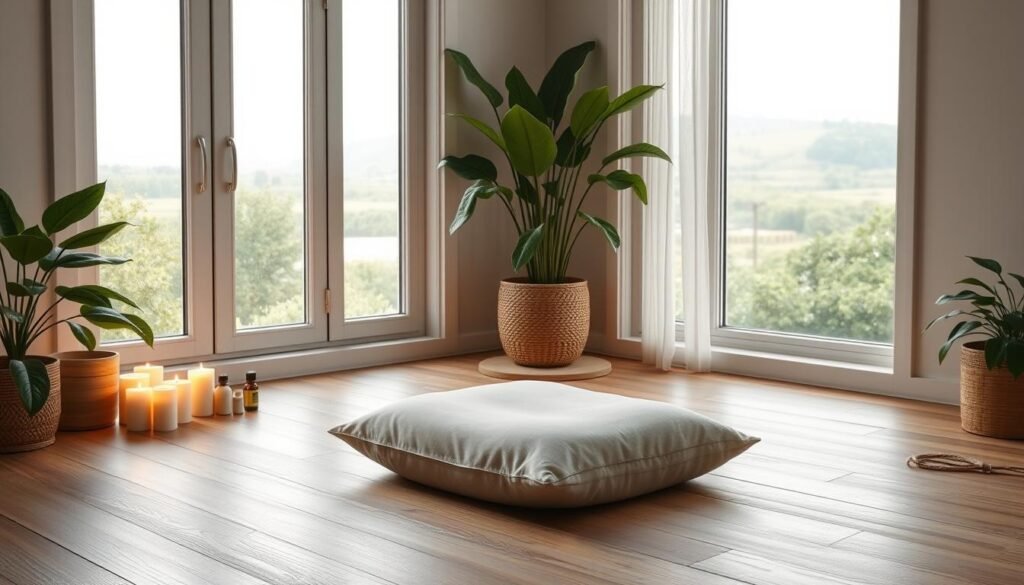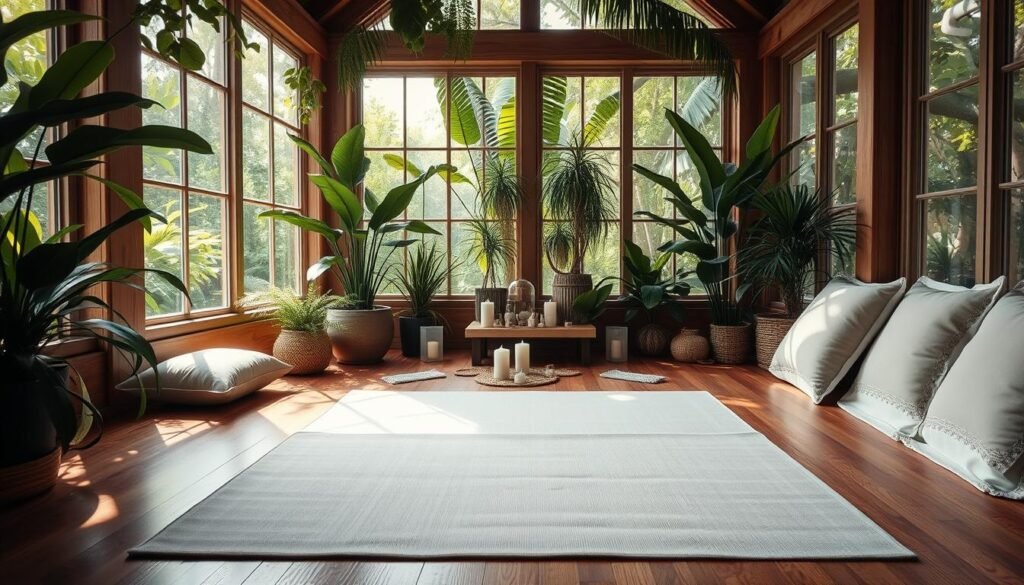In today’s world, stress and chaos are everywhere. But, is there a way to find peace and calm? Meditation is the answer. Led by Steven Webb, a top meditation teacher, “My Peaceful Place” offers a calm escape for those seeking mental peace.
Steven Webb’s meditation podcast has helped over 1 million people find solace. Despite being quadriplegic for over 30 years, his unique perspective has made him a leading voice in meditation.
So, how does meditation help with anxiety? Let’s explore the science behind it and its benefits for your mind.
Key Takeaways
- Discover the power of meditation to find inner peace and relief from anxiety
- Learn from renowned meditation teacher Steven Webb, who has over 1 million podcast listeners
- Explore the science behind how meditation affects brain chemistry and the mind-body connection
- Understand the transformative benefits of regular meditation practice
- Unlock essential techniques and approaches to get started with your own meditation journey
Understanding the Power of Meditation for Mental Wellness
Meditation is a powerful tool for mental wellness. It helps manage anxiety and promotes emotional balance. The science behind meditation shows its deep impact on our minds and bodies.
The Science Behind Meditation and Stress Response
Studies show meditation can control our stress response. Tibetan monks, with up to 35 years of practice, have seen brain changes. Their brains show less activity in areas linked to stress and mind-wandering.
How Meditation Affects Brain Chemistry
Meditation changes our brain’s structure and function. Regular practice increases myelin, improving brain connections. It also boosts cognitive skills and lowers stress hormones.
The Mind-Body Connection in Anxiety Management
Meditation affects our body’s health too. It lowers heart rate and blood pressure, leading to better health. It also helps with anxiety, depression, and heart disease.
Meditation offers many benefits, from better emotional control to stress management. It’s backed by scientific evidence. Whether through guided sessions or mindfulness, meditation’s effects are profound.

Getting Started: Essential Requirements for Meditation Practice
Starting a meditation journey is a big step towards feeling less anxious and more peaceful inside. To start, find a quiet, comfy spot where you can sit or lie down without distractions. Relaxation exercises and calming routines can make your meditation better.
If you like using headphones, make sure the cord is safe from your neck. Close your eyes and follow the guide. Let your mind go to a calm place. With just a quiet spot and maybe headphones, you can begin your meditation journey.
| Requirement | Description |
|---|---|
| Quiet, Comfortable Space | Find a peaceful, distraction-free area where you can sit or lie down comfortably. |
| Headphones (Optional) | Use headphones for guided meditations, ensuring the cable is positioned safely. |
| Relaxation Exercises | Engage in gentle stretches or calming routines to prepare your mind and body. |
With these basics, you can start your meditation journey. It’s a life-changing practice that can bring you great benefits.
“Meditation is not about clearing your mind, it’s about focusing your mind.” – Deepak Chopra

The Transformative Benefits of Regular Meditation
Adding meditation to your daily life can change you in amazing ways. It boosts both your physical and mental health. Mindfulness helps you build emotional strength and find ways to handle stress better.
Physical Health Improvements
Meditation does more than just calm your mind. It also improves your body. It can lower blood pressure, make your heart healthier, and boost your immune system. Meditation helps by calming your nervous system, which reduces stress hormones.
Emotional Balance Enhancement
Meditation is great for your emotional health. It helps you understand yourself better and handle stress. This leads to feeling more grateful and happy overall.
Better Sleep Quality
Stress and anxiety can mess up your sleep. But meditation can help. People who meditate regularly sleep 40% better than those who don’t. This is key for feeling emotionally strong and reducing stress.
Meditation is powerful because it tackles anxiety and stress at their source. It helps you find peace and improve your life. By making meditation a part of your day, you can feel more emotionally balanced and physically well.

Creating Your Perfect Meditation Space
Creating the perfect meditation space is key to a consistent and transformative practice. It should be a calm haven where you can escape daily stress and focus on the present. By designing a space for relaxation, you can fully enjoy meditation and find deep inner peace.
The perfect meditation space focuses on texture, scent, and lighting. Use soft, natural materials like cushions and blankets for a soothing touch. Calming scents from diffusers or candles quiet the mind. Soft lighting helps you focus and feel grounded.
In cities, adding plants, stones, or greenery can make your space feel like an oasis. Personal touches like artwork or crystals make your space unique and special.
Balance is important in designing your meditation space. Don’t overcrowd it with too many items. Instead, choose elements that calm your senses and support your meditation.
Your meditation space should match your needs and preferences. Try different things and listen to your intuition. Create a space that feels serene and supports your well-being.
“Having a designated meditation space can minimize distractions and interruptions during practice, helping to establish a routine and habit conducive to meditation.” – Jeremiah Brent, interior designer and meditation enthusiast

- Soft, natural materials like plush cushions and warm blankets can create a soothing, tactile experience.
- Calming scents from essential oil diffusers or candles can help quiet the mind.
- Soft, natural lighting can promote a sense of grounding and focus.
- Incorporating natural elements like plants, stones, or greenery can transport you to a serene oasis.
- Personal touches, such as meaningful artwork, chimes, or crystals, can further personalize your meditation space.
By designing a space that resonates with your senses, you can unlock meditation’s full benefits. Experience a profound sense of inner peace.
Meditation for Anxiety Relief: Core Techniques and Approaches
People looking to ease anxiety through meditation can try different techniques. These include focusing on breath, scanning the body, and observing thoughts and feelings. These methods can help lower stress, calm the mind, and bring peace within.
Breath-Focused Meditation
Breath-focused meditation is a key way to fight anxiety. It involves paying attention to your breath, noticing how it moves in and out. This helps keep your mind in the present, stopping worries from taking over.
Body Scan Techniques
Body scan meditation is another helpful method. It’s about focusing on each part of your body, feeling any tension. This practice can ease physical signs of anxiety, like tight muscles and a racing heart.
Mindful Observation Methods
Mindful observation teaches you to watch your thoughts and feelings without judgment. It helps you see them come and go, without getting caught up. This way, you can stay calm and balanced.
Regular use of these meditation techniques can make managing anxiety easier. They help you find peace and well-being.
“Just 10 minutes of mindfulness meditation can help individuals with anxiety improve their focus and task performance.”
Guided Meditation: A Journey to Inner Peace
Guided meditations are a great way to find peace in our busy lives. “My Peaceful Place” by Steven Webb is a calming 11-minute session for everyone. Webb’s soothing voice has helped many people relax and feel less anxious.
People love this meditation, giving it 5 out of 5 stars. They say it’s great for reducing stress and anxiety. One person said, “This meditation is a must-have for me every day. It helps me find peace in the chaos.”
“My Peaceful Place” is free from ads, making it a pure experience. Steven Webb, with over 30 years as a quadriplegic, brings real empathy to his guidance. His experience helps listeners find solace and calm.
“This meditation has become an indispensable part of my daily routine, helping me find peace and clarity amidst the chaos.”
This meditation has helped over 1 million people, earning a 5-star rating. It’s perfect for anyone looking to manage anxiety and find mindfulness. Steven Webb’s guided journey is a valuable tool for your mental well-being.
Incorporating Mindfulness into Daily Routines
Adding mindfulness to your daily life can help manage anxiety and improve mental health. By setting aside time for calming routines, you can find inner peace. This peace can spread throughout your day.
Morning Meditation Rituals
Begin your day with a morning meditation ritual. Spend 10-15 minutes in quiet, focusing on your breath or a guided meditation. Studies show mindfulness can lower stress and boost your immune system.
Mindful Moments Throughout the Day
- Take short mindfulness breaks at work to stay focused. Simple acts like deep breathing or a body scan can help.
- Make daily activities like eating lunch or walking mindful. This can improve sleep and boost energy and productivity.
Evening Wind-Down Practices
End your day with a mindfulness routine. This could be a meditation, gentle yoga, or reflecting on the day with gratitude. Mindfulness can help with health issues like back pain and diabetes.
By making mindfulness a part of your daily life, you can improve your mental health and resilience. Aim to practice mindfulness daily for six months. This will make it easier and more beneficial over time.
Overcoming Common Meditation Challenges
Starting a meditation for anxiety relief journey can be very rewarding. But, it comes with its own set of challenges. These include trouble focusing, feeling restless, and finding time to meditate. Yet, with the right mindset and strategies, you can overcome these obstacles. This way, you can fully enjoy the benefits of mindfulness techniques and find inner peace.
One big challenge is keeping your focus during meditation. This is especially hard for those with busy minds. But, studies show that regular meditation can help your brain stay focused. By gently bringing your attention back to your breath or a mantra, you can improve your focus over time.
Restlessness is another common problem during meditation. It might make you want to move or feel uncomfortable. To tackle this, try different meditation positions, add gentle stretches, or just accept the restlessness as part of the process.
Finding time to meditate can be tough in today’s fast world. It’s hard to find moments for self-care. But, research shows that even short sessions of 5-10 minutes can help reduce anxiety and improve well-being. By adding mindfulness techniques to your daily life, like in the morning or during breaks, you can make meditation a regular part of your routine.
Remember, overcoming meditation challenges is a journey, not a goal. Be patient, kind to yourself, and open to change. With these attitudes, you can overcome obstacles and enjoy the benefits of meditation for anxiety relief. Celebrate your progress and enjoy the deep benefits of a consistent mindfulness practice.
“The greatest weapon against stress is our ability to choose one thought over another.” – William James
Advanced Meditation Techniques for Anxiety Management
Looking for deeper relaxation and stress relief? Try advanced meditation techniques like visualization, progressive muscle relaxation, and mantra-based meditation. These methods can help manage anxiety and bring inner peace.
Visualization Exercises
Visualization exercises create mental images that calm the mind and body. Imagine peaceful landscapes, a warm hug, or tension leaving your body. These images can activate your relaxation system and reduce anxiety.
Progressive Muscle Relaxation
Progressive muscle relaxation involves tensing and releasing muscles. It makes you aware of your body and helps release tension. This can ease anxiety symptoms like headaches and shallow breathing.
Mantra-Based Meditation
Mantra-based meditation uses repeated words or sounds, often in Sanskrit. The soothing rhythm helps quiet the mind and reduce anxiety. It promotes deep relaxation and self-acceptance, key for managing anxiety.



